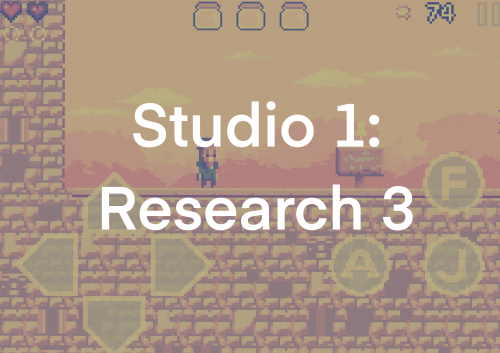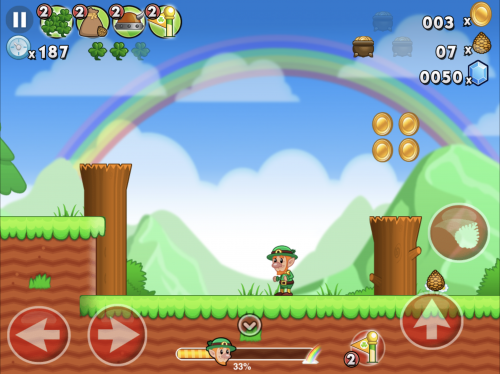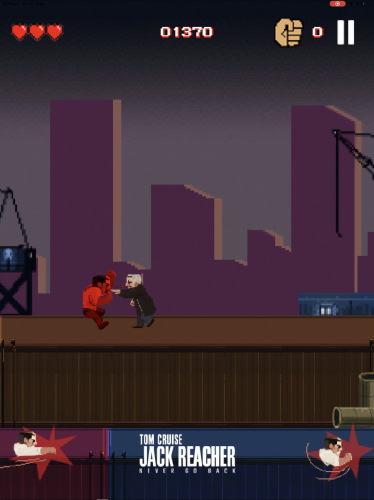This week I played through 7 different platformers from a variety of creators and took some notes.
Lep’s world 2 is a 2D side scroller for iPad, made by nerByte GmbH. It employs many of the same mechanics as traditional Nintendo games. The player moves left to right across a space filled with destructible blocks and squashable enemies, both static and moving. The player character has projectiles which he can employ to destroy blocks and disable/ kill enemies.
Leps World 2 is effectively a free mario remake featuring Mario’s extensive symbol, obstacle, enemy, level and movement languages with some of the imagery changed around. This takes advantage of the average person's familiarity with one of the staples of the genre, avoiding any explanations of mechanics or meanings and simply perusing on as though the player knows what they’re doing, without distracting pop up explanations.
By essentially creating a new 2D side scroller Mario Game from scratch, I believe the creators of Lep’s World evolve Mario into something more along their own lines of a good or efficient game. The player can now fire projectiles without a power up, for example.
Goku to Hell is a side scroller app for iPad by 25Gamer. It is about a man, possibly a carpenter or rogue, travelling through a castle, solving puzzles and defeating enemies, with no clear cut goal in mind. There is no Princess to rescue and there are no cutscenes. It is up to the player to determine their narrative from context.
It’s mechanics are patterned after Super Mario World 2 and Castlevania 1, in that the goal is not just to move right but to climb slowly upward, in this case into a castle.
The game’s aesthetics are patterned after classic pixel art games of the 1980s, with a blocky aesthetic and a limited colour palette. The colours are blocked out in the extreme background and on the characters, while items, platforms and objects are usually dithered and detailed.
The colours used in the game really stood out to me. From what I could piece together, the main character is valiant and Christian, gathering holy water as his overall goal, and smiting others, usually knights, with magical fire. The medieval landscape and moral compass is emphasised neatly by the rich orange, peach and tan aesthetic. The game feels somewhat like a scroll or an ancient painting.
The controls are large, difficult to time and distracting.
Mr Crab 2 is a 3D side scroller app for iPad by Illusion Labs. It is about a large male crab rescuing a variety of tiny collectable baby crabs from various puzzles constructed around rotating 3D spirals.
The most intriguing aspect of Mr Crab are the controls. There is no turning, firing or crouching, only jumping a little or jumping a lot. Mr Crab moves at a set speed and turns to face the other direction only when he bumps into an object. MrCrab’s levels are intricately constructed with this minimal control scheme in mind. In my opinion, it was one of the more deliberately planned and unique games out of the 7 I played.
The game is likely built for small children, and thus it creates a world where only very simple controls are ever needed or used. The only complexities it presents are the placement of the baby crabs and the difficulties in getting Mr Crab to them, sometimes passing them completely and unable to go back.
One aspect of Mr Crabs design that I really appreciate is its blurry basic moving backgrounds. There’s a terrific Tony Zhou essay about Stephen Spielberg’s Jaws, where he mentions that a constantly moving background, even over still characters, gives the viewer the illusion of multiple locations/atmospheres, just enough to keep us sated, keep the viewer's eye from getting bored. I believe something similar was employed in the backgrounds of this game, especially considering the foregrounds reuse assets over and over again. Just a clever little idea that brings the game together in a smart way.
Jack Reacher : Never Stop Punching is a promotional game for the film Jack Reacher: Never Go Back, by Paramount Digital Entertainment. It features only two controls, punch and jump-punch, as the Jack Reacher character moves at a steady pace forward through a shipping yard, punching bad guys.
The buttons to play are positioned at each side of the screen, much like a player may have used a very old arcade cabinet or pinball machine. The aesthetic style is classic pixel art, but with a wider colour pallet. The game only features one long level, eventually panning through several looping locations, presumably from the film its promoting, or possibly just fun 1980s cliched action movie locations.
The title and content center around punching as an idea, teasing out the joke that manly violence in old video games and action films is excessive and extreme, even absurd, but fun in its absurdity. Jack Reachers character design: huge shoulders, grimacing face and massive fists that are the dominant objects in both his fighting and running animations, emphasise this in a fun way.
Space Force is a basic platformer, side scroller game by Michael Olson. Much like Jack Reacher, the player moved forward at a steady pace in an uncontrolled way, and in the same way as Mr Crab the only controls are to jump for short and long periods of time by holding your finger down.
The basic ness of the games mechanics and art weren’t lost on me. The sprite continues their walk animation even when they’re jumping or hovering in the air. The backgrounds are all identical and the games assets consist of brown boxes, spikes and a rocket. But as the game goes on, I did get a sense of how much could be done with so little. Eventually there are vertical platforms and sideways spikes and other fun things all modified out of the few assets the game has.
One of the more interesting mechanics is that the game keeps track of how often you’ve died from the beginning to the end, leaving you with a tally of hundreds of deaths by the third level alone. This along with the finicky controls leaves the player with a sense of, quite possibly intentional, frustration with the game‘s creators. Maybe something worth thinking back to if I would ever like to build a game with an implied game developer character in a meta narrative, like in Davey Wreden’s 2015 game The Beginners Guide.
Abyss Fish is also a game I played, made in unity by Charles Jensen. It features an Anglerfish character moving through a 3D environment with only its coloured light to illuminate the players surroundings. It moves involuntarily forward, slowly gliding upward as the player’s taps move it down to avoid objects.
The game was made in unity about deep sea creatures and is very much up my alley in terms of potential influences.
I enjoy the aesthetic of the game, its glowing colour changing 3D model, its neon on black theme and its Menu fonts were all thought out and fun, selling to me a game brand similar to an early 2000s Banjo Kazooie / Conkers style game.
The game's mechanics seem totally alien from this, it's honestly quite laborious to play. There is no particular Anglerfish related goal, or any reason to be constantly drifting upward towards a ceiling that will kill you on impact. When the player moves down too fast and doesn’t have space to move up, they have to wait to die, sometimes for several long seconds, and start the game over again.
This game as well as Space Force, I believe, are capitalising on their finicky and difficult controls to create the main challenge for their players. Getting a hang of how to play the game is the entire challenge of the game. The difficult controls are the narrative.
There were several challenge games I played like this back in college, Flappy Bird and Cat Mario being famous examples, where the real accomplishment one gets from the game is bragging to your friends that you’re able to play it at all, let alone beat it. For newcomer game designers still figuring out how to build accessible intelligent controls, like me, this is an interesting market to build into. The gaming parts of the internet adore players who can teach themselves extreme specific game languages and timings. It’s a market that I’ve never considered creating for before, but have several ideas for now.
That being said, maybe it’s just bad.
Ninja Scroller is a 2D platformer app for iPad by Eageron GmbH. It also features an involuntarily moving character propelling forward extremely fast through a jungle of enemies traps and obstacles. The player is presented with 2 movements, jumping and attacking that we preemptively prepare for as our eyes dart ahead to see what enemies are coming.
The player is dropped into a quick sudden journey through a huge forest, pop up boxes telling us how to quickly attack or jump, and presenting us with a variety of earnable weapons to alternate between. Almost every aspect of the games mechanics suits the concept of a ninja game very intelligently. The quick pacing, fast thinking and brutal violence fit neatly into an implied archetypal ninja narrative.
The buttons are positioned on either side of the screen. “Jump” to our left, a basic button with only one function positioned somewhere we will barely have to look because there are no enemies on our left. And our selection of weapons and attack button over to the right, where the player will find themself looking for enemies anyway. I find this to be a clever way of organising the screen.
About This Work
By Holland Kerr
Email Holland Kerr
Published On: 23/08/2020


